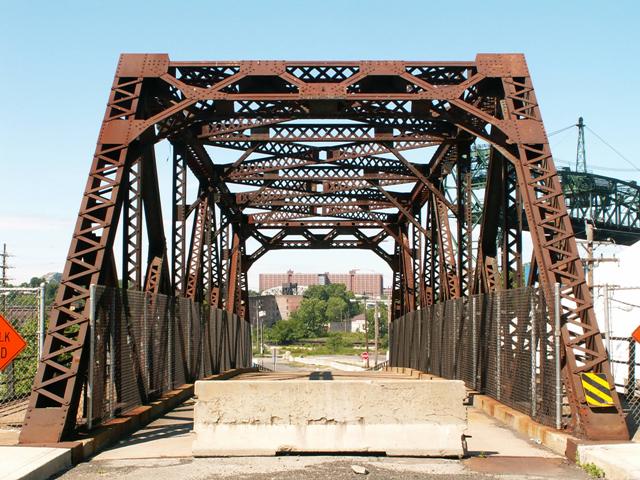We Recommend:
Bach Steel - Experts at historic truss bridge restoration.
Stones Levee Bridge

Primary Photographer(s): Nathan Holth
Bridge Documented: June 24, 2007
Cleveland: Cuyahoga County, Ohio: United States
1964
114.2 Feet (34.8 Meters)
121.0 Feet (36.9 Meters)
18 Feet (5.49 Meters)
1 Main Span(s)
1866389

View Information About HSR Ratings
Bridge Documentation
View Archived National Bridge Inventory Report - Has Additional Details and Evaluation
This bridge shares an intimate history with the Eagle Avenue Viaduct, which was demolished in 2005 with the exception of the vertical lift span. When the viaduct was built in 1928, it was built right over this bridge. People crossing the Stones Levee Bridge would be going under the viaduct, passing in between the steel bent supports of the viaduct. See the photo gallery for a few photos from ODOT showing this.
The Stones Levee Bridge is historically significant as one of the oldest truss bridges in Cleveland. It is also significant for being an uncommon highway example of a Baltimore truss configuration. The bridge features aesthetic qualities as well. The presence of v-lacing on the end posts and top chord is an uncommon, and welcome feature that adds to the beauty of the truss.
The loss of the viaduct is unfortunate, but it is worth noting that Stones Levee Bridge is a lot easier to photo now, and is much more photogenic. However, the Stones Levee Bridge has not been cared for, despite its historic and aesthetic value. The bridge has no paint, and rust is doing serious damage. However, the bridge could and should be restored, perhaps for pedestrian use. The bridge's parts should be sandblasted and cleaned, and worn parts replaced with replicated period-design parts, and the structure should be painted. Also, the ugly cyclone fencing on the bridge should be done away with.
Information and Findings From Ohio's Historic Bridge InventorySetting/Context The bridge carries a 2 lane city street and sidewalks over tracks of the B&O RR in a depressed section in downtown Cleveland. The setting is industrial. Physical Description The 1 span, 121'-long, rivet-connected Warren with verticals and subdivided panels thru truss bridge is heavily built with built-up members and cantilevered sidewalks with pipe railings. It has concrete abutments. Integrity Has integrity. Summary of Significance The 1908 rivet-connected Warren pony truss is among the early and complete examples of the truss type/design that would dominate county road truss bridge building in Ohio during the 20th century. There has been
no significant change in the bridge's status since the prior inventory. The eligible recommendation remains appropriate. Justification The bridge is one of over 40 extant riveted thru truss bridges of all designs built between 1904 and 1959. This example is representative of the population and has moderate significance. There are also many riveted thru truss bridges servicing the many rail lines in the state. Bridge Considered Historic By Survey: Yes |
![]()
Photo Galleries and Videos: Stones Levee Bridge
Bridge Photo-Documentation
A collection of overview and detail photos. This photo gallery contains a combination of Original Size photos and Mobile Optimized photos in a touch-friendly popup viewer.Alternatively, Browse Without Using Viewer
![]()
Maps and Links: Stones Levee Bridge
Coordinates (Latitude, Longitude):
Search For Additional Bridge Listings:
Bridgehunter.com: View listed bridges within 0.5 miles (0.8 kilometers) of this bridge.
Bridgehunter.com: View listed bridges within 10 miles (16 kilometers) of this bridge.
Additional Maps:
Google Streetview (If Available)
GeoHack (Additional Links and Coordinates)
Apple Maps (Via DuckDuckGo Search)
Apple Maps (Apple devices only)
Android: Open Location In Your Map or GPS App
Flickr Gallery (Find Nearby Photos)
Wikimedia Commons (Find Nearby Photos)
Directions Via Sygic For Android
Directions Via Sygic For iOS and Android Dolphin Browser
USGS National Map (United States Only)
Historical USGS Topo Maps (United States Only)
Historic Aerials (United States Only)
CalTopo Maps (United States Only)

